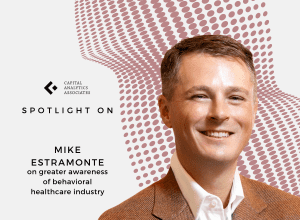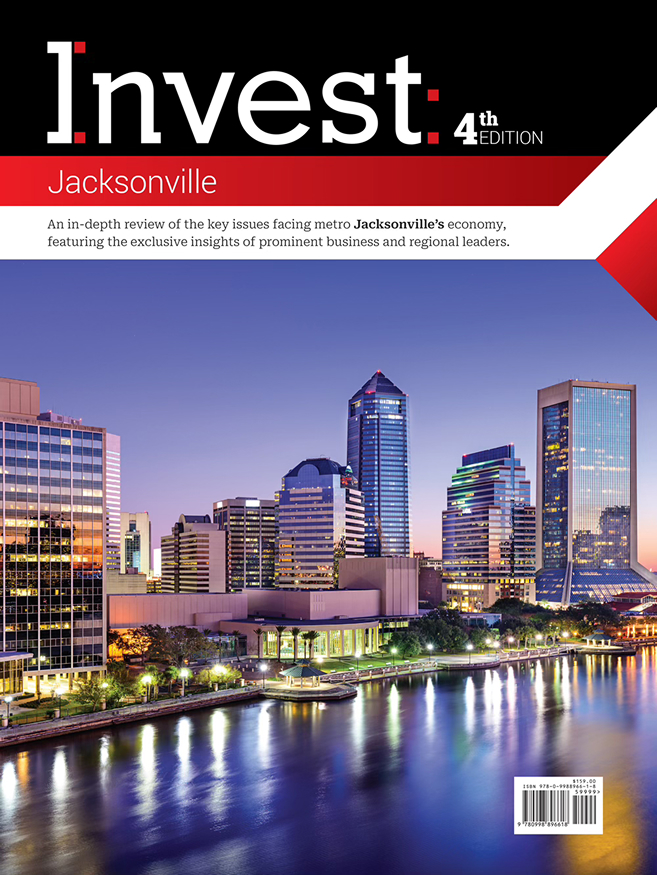Spotlight On: Mike Estramonte, Founder & CEO, StarMed Healthcare and Katie Blessing Center
 August 2024 — In an interview with Invest: Mike Estramonte, founder and CEO of StarMed Healthcare and Katie Blessing Center, discussed why a holistic and dignity-centered approach to patient care and facility design is needed, and how funding continues to be the primary challenge faced by the behavioral healthcare industry.
August 2024 — In an interview with Invest: Mike Estramonte, founder and CEO of StarMed Healthcare and Katie Blessing Center, discussed why a holistic and dignity-centered approach to patient care and facility design is needed, and how funding continues to be the primary challenge faced by the behavioral healthcare industry.
What are some of the projects that you are focused on and what differentiates the company from other care providers in Charlotte?
The core focus now is on the Katie Blessing Center. We essentially transitioned out of the pandemic, and did not want to downsize. Our mission has always been to go in, find the problem no one wants to tackle, and make a change.
I was at a reception here in Charlotte and ran into a couple of physicians who worked in the ED at Atrium. They were telling me about the problem they were having with children who were waiting in these emergency departments sometimes for weeks or months for a psychiatric bed when they were in crisis.
And that is how the idea for Katie Blessing came about. It started off as a smaller project, but once we identified the issue, we realized it was not just a lack of beds, but it was a lack of continuity of care. These children are being sent not just to nearby states like Virginia, but all the way to Illinois and California for psychiatric beds.

We also need to solve this holistically by putting in a significant outpatient program and behavioral health urgent care that specializes in children and adolescents. This would allow parents and guardians a choice, rather than taking their child to the ED. They could take them to an urgent care center, have them evaluated, and if appropriate, admit them into the facility or send them to outpatient programs.
This option is lacking not just in Charlotte, but across the entire state of North Carolina. With 72 beds for pediatric care, we will be the largest in the state of North Carolina. All the architectural plans have been designed, and the project has been built out. Initially, it was around a $20 million project; however, now it is just over $60 million. We have raised $50 million of the $60 million needed, so we are just in the final efforts to raise the remaining $10 million.
What are some other major challenges and opportunities that you are seeing in the larger healthcare industry, and how are you addressing them?
Right now, my focus is on psychiatric medicine. The main challenge is proper funding. The behavioral healthcare industry, in particular, needs more awareness. Many facilities are creating band-aid fixes, which are necessary, like emergency placement shelters and crisis units, but we also need to think long-term. What is lacking right now is a concrete, long-term plan that we can stick to for the next five, 10, or 15 years.
What measures have you undertaken to enhance patient outcomes, especially with your support programs, such as your music and art therapy programs?
What you often see when touring other facilities, not just here in North Carolina but across the country, is that many still feel very institutional. It is hard to believe that in the year 2024, many of these facilities still feel like jails. When you walk in, you think, “This is not a place of healing.” That was one of our primary concerns. We need to make sure that when children and adolescents come into this facility, they feel dignity and respect. The facility should be clean, bright, and welcoming.
We have put a lot of thought into everything, even down to the outfits the kids wear when they come in, often with only the clothes on their backs. We make sure they have a choice, rather than just being given a tan-colored scrub, which is what you see in many facilities. We have developed what we call a Children and Adolescent Advisory Board, where kids give us their recommendations.
Quality of care also means ensuring we are properly staffed. There are many challenges in the behavioral health world, especially with facilities like this. For example, staffing is a major issue. Many people feel called to do this work, but there is a high level of burnout because they are dealing with some of the most challenging cases day in and day out. When a child is going through a psychiatric crisis, it is tough, and we need to ensure that our staff feels respected and protected.
Lastly, you never want to say that pay matters, but it does. If you are a social worker in one of these facilities, you need to be paid a percentage higher than your peers because of the stress involved. But historically, these facilities have been underfunded, not just for construction like we are doing here, but for operational purposes as well. Fee schedules do not meet the requirements to pay staff properly. There are many challenges, but building awareness, through interviews such as these, allows people to understand what the challenges are and think about what they can do to help.
[fusion_images order_by=”desc” picture_size=”auto” hover_type=”none” autoplay=”yes” autoplay_speed=”3000″ flex_align_items=”center” columns=”1″ column_spacing=”0″ scroll_items=”” show_nav=”yes” mouse_scroll=”no” border=”no” lightbox=”no” margin_top=”” margin_right=”” margin_bottom=”” margin_left=”” hide_on_mobile=”small-visibility,medium-visibility,large-visibility” class=”” id=”” caption_style=”off” caption_title_tag=”2″ fusion_font_family_caption_title_font=”” fusion_font_variant_caption_title_font=”” caption_title_size=”” caption_title_line_height=”” caption_title_letter_spacing=”” caption_title_transform=”” caption_title_color=”” hue=”” saturation=”” lightness=”” alpha=”” caption_background_color=”” fusion_font_family_caption_text_font=”” fusion_font_variant_caption_text_font=”” caption_text_size=”” caption_text_line_height=”” caption_text_letter_spacing=”” caption_text_transform=”” caption_text_color=”” caption_border_color=”” caption_overlay_color=”” caption_align_medium=”none” caption_align_small=”none” caption_align=”none” caption_margin_top=”” caption_margin_right=”” caption_margin_bottom=”” caption_margin_left=”” parent_dynamic_content=””] [fusion_image image=”https://capitalanalyticsassociates.com/wp-content/uploads/2024/07/CAA24_Invest-Insights-S6-Web-Banners-7.jpg” image_id=”64377″ image_title=”” image_caption=”” link=”” linktarget=”_self” alt=”” /] [fusion_image image=”https://capitalanalyticsassociates.com/wp-content/uploads/2024/07/CAA24_Invest-Insights-S6-Web-Banners-10.jpg” image_id=”64380″ image_title=”” image_caption=”” link=”” linktarget=”_self” alt=”” /] [fusion_image image=”https://capitalanalyticsassociates.com/wp-content/uploads/2024/07/CAA24_Invest-Insights-S6-Web-Banners-9.jpg” image_id=”64379″ image_title=”” image_caption=”” link=”” linktarget=”_self” alt=”” /] [fusion_image image=”https://capitalanalyticsassociates.com/wp-content/uploads/2024/07/CAA24_Invest-Insights-S6-Web-Banners-8.jpg” image_id=”64378″ image_title=”” image_caption=”” link=”” linktarget=”_self” alt=”” /] [/fusion_images]
How do you envision the future of behavioral care in the next two to three years?
Since the pandemic, there has been more awareness about behavioral care, and funding has improved, though not enough. After working on this project and going full discovery mode, I have realized that the situation is quite dire. If people knew how bad it was, it would be on the front page of every newspaper every day. The media should talk about it daily until we build enough awareness to put a significant fix in place. You will never fix it 100%, but we must build as much awareness as possible.

Right now, we are in fundraising mode. We have raised $50 million out of the $60 million we need, and we have done it in a very short period — less than two years. I have heard of projects like this taking five to 10 years. The only thing holding us up now is the last $10 million. Once we secure that, we can start construction, and the facility will be open within 12 months.
It is hard to believe that $10 million out of $60 million is all that is holding us back from building this facility, which will make a significant impact on the challenges North Carolina is facing.
What are your top priorities and goals over the next two to three years?
Once the center is open, many people who have contributed are already asking if we will build more facilities in rural North Carolina. I agree that we need them, but I want to focus on doing this one really well first. I want to build a template for it. There will never be a non-disclosure agreement in our world. I want our facility to be an open book so that if we find significant success in running this type of facility, we can share the playbook, not just here in North Carolina but across the country.
When an entrepreneur can partner with the government in a transparent way that moves society forward, that is a significant solution. So, to answer your question, our top priority is to open this center and make sure it works from both a human and economic standpoint. Then we want to be able to show it to everyone so it can be duplicated, not just by us.
For more information, please visit:













